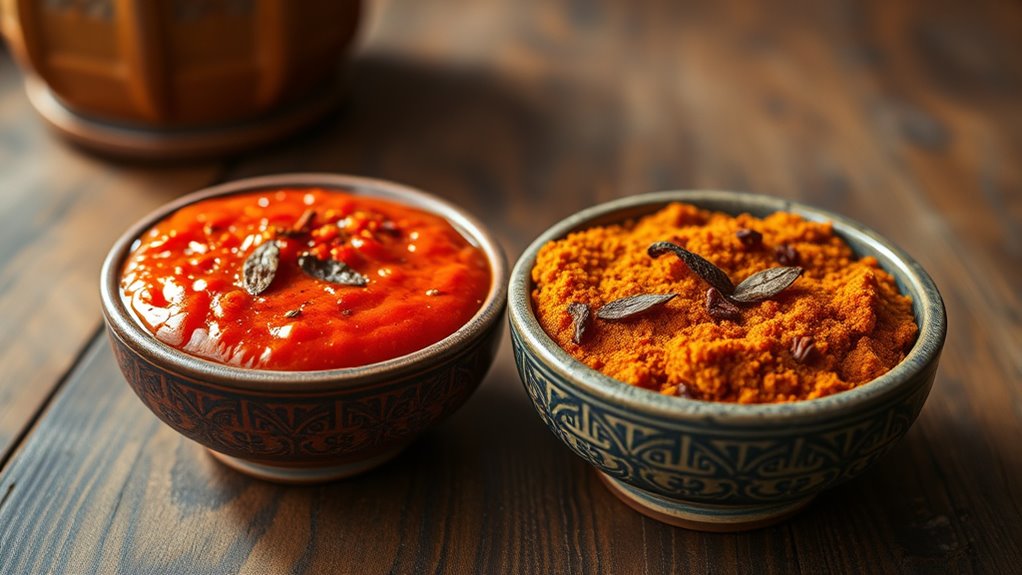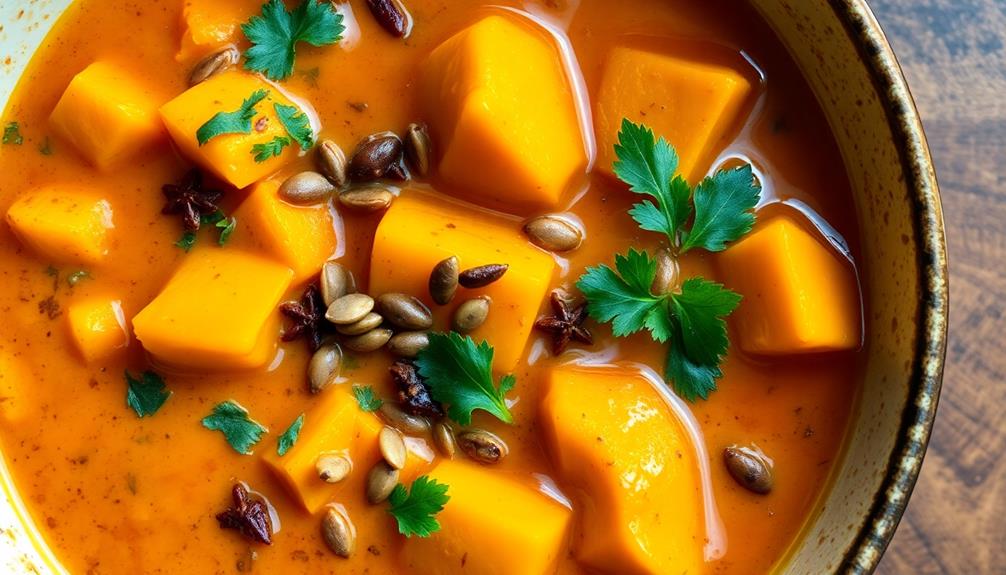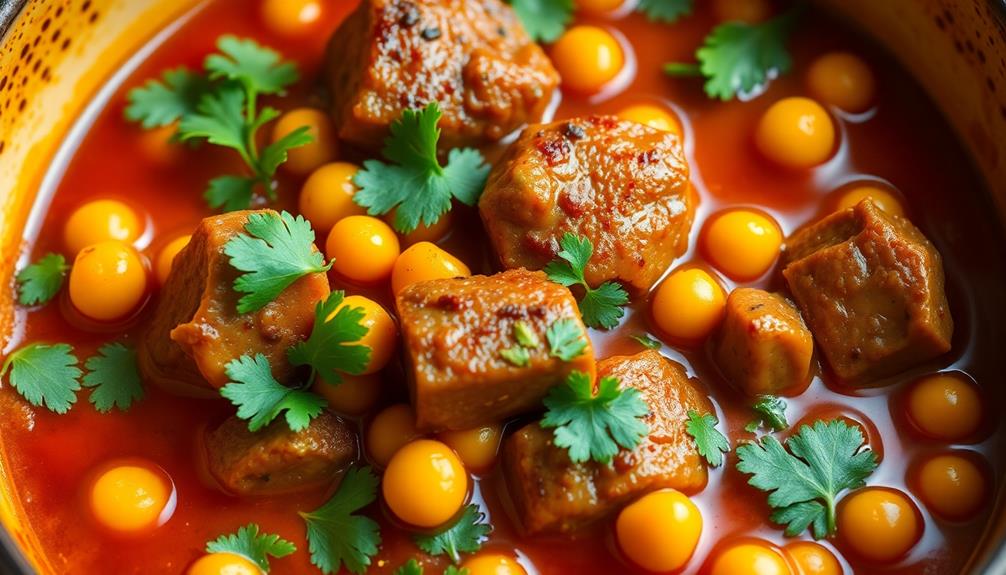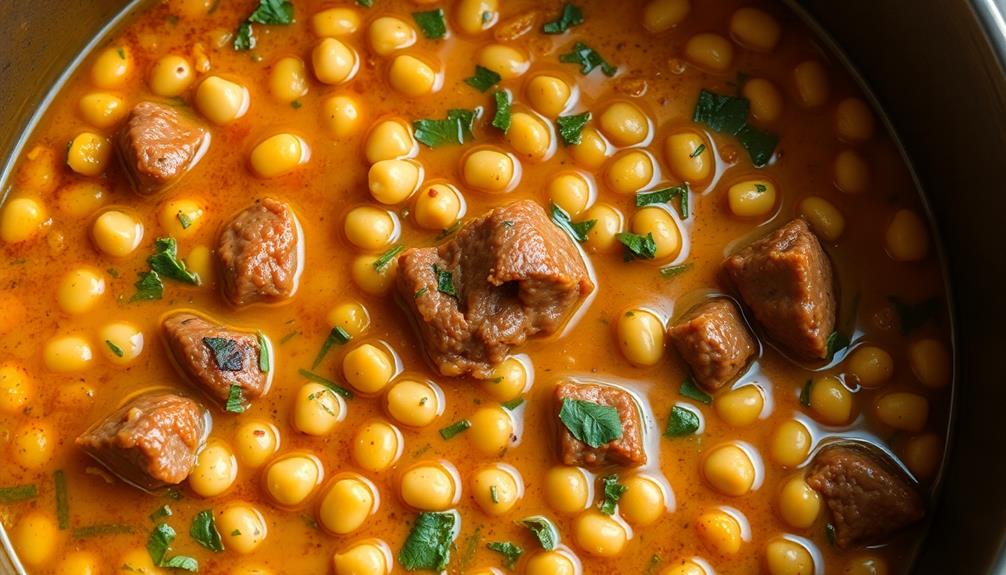Mitmita packs a fiery punch with intense heat from dried red chili peppers, making it much spicier than Berbere, which offers a more complex, layered flavor with moderate heat from spices like cinnamon, ginger, and fenugreek. While Mitmita is used sparingly for a bold, pungent kick, Berbere balances heat with sweetness and earthiness, suitable for a wide range of dishes. To discover how these spices truly differ, explore how each enhances Ethiopian cuisine.
Key Takeaways
- Mitmita is significantly spicier with a fiery, pungent heat primarily from dried red chili peppers; berbere has a milder, layered heat.
- Mitmita delivers an intense, sharp heat that can overpower dishes, while berbere offers a balanced warmth with aromatic complexity.
- Mitmita’s flavor focuses on bold, smoky chili heat; berbere combines heat with sweet, earthy spices like cinnamon and ginger.
- Mitmita is used sparingly for a fiery punch, whereas berbere’s moderate heat enhances a wide range of dishes.
- The heat scale of Mitmita surpasses that of berbere, reflecting its role as a fiery condiment versus the more nuanced spice blend.
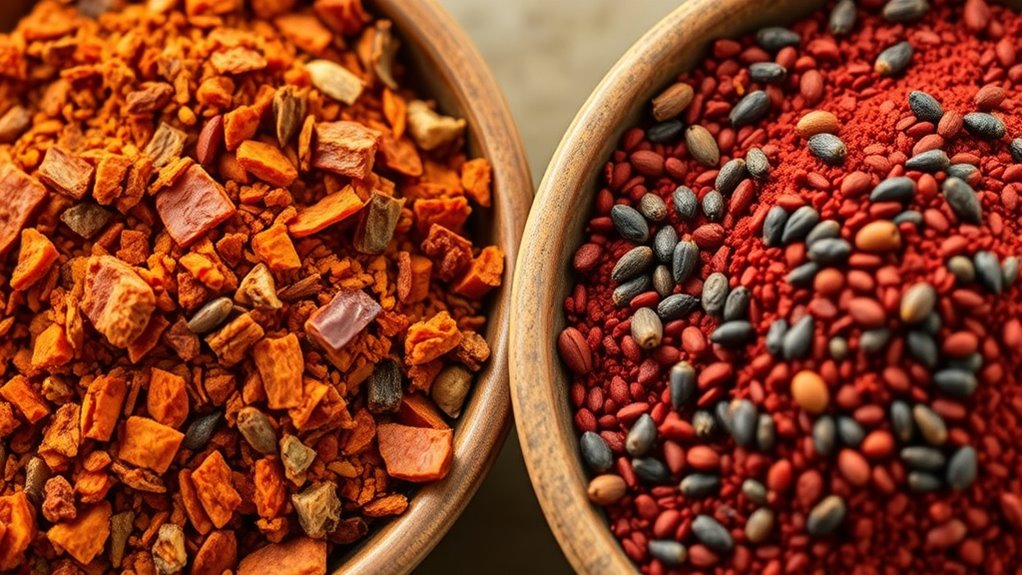
Have you ever wondered how Ethiopian spices like Mitmita and Berbere compare? Both are essential to Ethiopian cuisine, but they bring distinct flavors and heat levels to the table. To really appreciate their differences, it helps to explore their flavor profiles and spice origins. This understanding will guide you in using them appropriately in your cooking and help you decide which one suits your taste buds best.
Mitmita is a fiery, vibrant spice blend that originates from the Afar and Oromo regions of Ethiopia. Its spice origins trace back to ancient trade routes, where it was valued for its intense heat and bold flavor. The core ingredients include dried red chili peppers, often smoked or sun-dried, which give Mitmita its characteristic fiery kick. Alongside the chilies, you’ll find spices like cardamom, cloves, and salt, which add aromatic depth and a slightly savory undertone. The flavor profile of Mitmita is sharp and pungent, with a pronounced heat that can overpower more subtle tastes if you’re not careful. Its spiciness is not just about heat; it also imparts a complex, earthy aroma that enhances grilled meats, stews, and even vegetables. Because it’s quite hot, Mitmita is often used sparingly but makes a significant impact when added to dishes. Spice blending techniques are crucial to achieving the perfect balance in Mitmita.
Mitmita is a fiery Ethiopian spice blend with intense heat and bold, earthy flavors.
Berbere, on the other hand, has a more complex flavor profile and a broader spice origin story. It’s a versatile Ethiopian spice blend that combines a variety of ingredients, including chili peppers, garlic, ginger, fenugreek, coriander, and cinnamon. Its spice origins are linked to the highland regions where a mix of indigenous and trade-influenced spices have been combined for centuries. The flavor profile of Berbere is rich and layered, offering a balance of heat, sweetness, and earthiness. Unlike Mitmita, which emphasizes heat, Berbere provides a smoky, slightly sweet, and aromatic experience. The inclusion of spices like cinnamon and fenugreek lends a warm, fragrant quality that complements stews, lentils, and bread. The heat level in Berbere is generally milder than Mitmita, but the complexity of spices creates a satisfying depth that’s hard to match. Additionally, the traditional spice origins of Berbere highlight its deep cultural roots and regional variations, making it a staple in Ethiopian kitchens. Proper storage of Berbere also preserves its vibrant flavors over time.
Understanding these differences helps you decide which spice blend to use for your cooking. If you prefer dishes with a fiery punch and intense heat, Mitmita is your go-to. But if you enjoy a layered, aromatic flavor with moderate heat, Berbere will serve you better. Both spices reflect Ethiopia’s rich culinary history and spice origins, offering unique ways to elevate your meals.
Frequently Asked Questions
Can Mitmita and Berbere Be Used Interchangeably in Recipes?
You can sometimes use mitmita and berbere as a spice substitution, but keep in mind they have distinct flavors. Mitmita offers a fiery heat and straightforward spice, while berbere provides a complex, layered flavor profile. For flavor pairing, consider the dish’s overall taste. Swapping them works best in recipes where heat is key, but be prepared for a different flavor experience. Adjust quantities to match your preferred spice level.
Which Spice Blend Is More Suitable for Sensitive Palates?
If you’re sensitive to spicy flavors, mild spice blends are your best bet. Mitmita tends to be more intense, so it might overwhelm your palate, while berbere offers a balanced flavor complexity with less heat. You should choose berbere for a flavorful, less fiery experience that still provides rich, aromatic spices. This way, you enjoy the depth of Ethiopian cuisine without the heat being too overwhelming.
Are There Regional Variations of Mitmita and Berbere Within Ethiopia?
Imagine discovering hidden culinary treasures in Ethiopia’s diverse regions. You’ll find local spice variations that create unique regional flavor profiles. Within Ethiopia, mitmita and berbere vary subtly, influenced by local ingredients and traditions. These regional differences evoke a sense of cultural richness, making each blend special. Exploring these variations lets you appreciate Ethiopia’s vibrant culinary tapestry, where every region’s twist adds depth and character to the beloved spice blends.
How Do Storage Methods Affect the Flavor of Mitmita and Berbere?
You might wonder how storage methods impact mitmita and berbere. Proper storage critically affects flavor preservation, preventing spice loss and flavor change. Keep these spices in airtight containers away from heat and light to maintain their vibrant flavors and heat levels. Avoid moisture exposure, which can cause spoilage. By storing them correctly, you guarantee your spices stay fresh, potent, and flavorful for longer, enhancing every dish you prepare.
What Are Some Common Dishes That Specifically Highlight Mitmita or Berbere?
You’ll find that dishes like Doro Wat and Tibs truly shine when seasoned with berbere, highlighting its complex, smoky flavor. Mitmita, with its fiery kick, is perfect for spice pairing in more intense dishes like kitfo or spicy stews. These spices carry deep cultural significance, transforming simple ingredients into Ethiopian culinary masterpieces. When used thoughtfully, they turn everyday meals into a flavorful celebration of tradition and vibrant flavors.
Conclusion
Now that you’ve explored Ethiopian mitmita and berbere, you see their unique heat levels and flavors. If you prefer a fiery kick, mitmita’s your go-to, while berbere offers a complex, smoky warmth. Think of it as choosing between a quick spark and a steady flame—you’re in control. Whichever you pick, remember, the proof of the pudding is in the eating, so don’t be afraid to experiment and find your perfect balance of spice and flavor.
